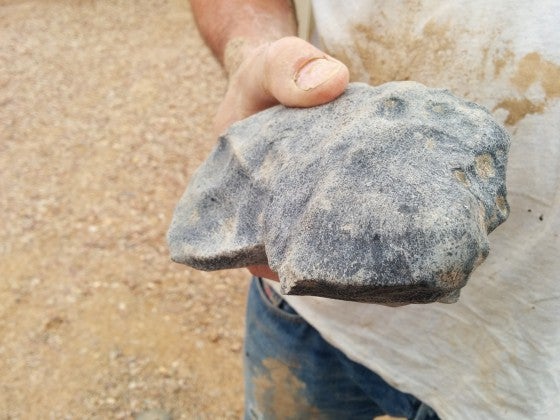4.5 billion-year-old meteorite discovered in Australian outback could help reveal the origins of the solar system
The meteorite was discovered just hours before heavy rain would have destroyed all evidence of its landing

A meteorite older than the Earth that researchers discovered embedded in the crust of a dried lake in southern Australia could help us understand more about the origins of the solar system.
The 1.7-kilogram meteorite was found by a team of geologists and researchers from Perth's Curtin University, after a painstaking search that was conducted just hours before heavy rainfall which would have destroyed all visible traces of the meteorite's landing.
Five remote cameras located around the dried bed of Lake Eyre, which are designed to detect falling meteorites, spotted the object as it came down to Earth, ABC reported.
Using the images, the team managed to triangulate the meteorite's path, and narrowed their search area down to a 500-metre line in the middle of the lake.
In the three-day search that followed, an aerial spotter, a drone, researchers Robert Howie and Phil Bland and local Aboriginal guides Dean Stuart and Dave Strangways combed the soft clay of the lake bed in search of the telltale crater created by the meteorite when it hit the Earth.
It was finally found on New Year's Eve, and Bland had the honour of digging out of the ground.

At around 4.5 billion years old, the meteorite is a prime sample of the kind of material that was created during the early days of the solar system.
Gathering samples of meteors and conducting tests to determine their chemical make-up and formation can give us an unparalleled insight into the history of Earth and the solar system.
When we study rocks from Earth, we're looking at items that have been processed and altered by geological forces over millions of years.
Meteorites have not been subject to these forces, and studying them allows us to look at the chemical composition of the solar system in its infancy - which is crucial to our understanding of the Earth's distant history.
That's why space agencies around the world have planned and launched missions to land probes on asteroids and meteors, in order to drill for samples and gain the incredibly valuable scientific material within.
As Bland told a press conference after the meteorite's discovery: "It is a big deal because space agencies like Nasa or Jaxa [the Japanese space agency] will spend a billion dollars trying to get to an asteroid and bring a sample back."
Commenting on his discovery, he added: "Potentially, we can do it for an awful lot less than that."
Meteorites, or pieces of meteor that have survived a fall to Earth, are typically named after the area in which they are found, or after the people who discover them.
However, the researchers asked the local indigenous folk, the Arabana people, to name the meteorite in their own language, which only has around 20 surviving speakers.
In the meantime, another 10 potential falls were spotted by the meteorite-spotting cameras, which the team are planning to investigate in the near future.
Join our commenting forum
Join thought-provoking conversations, follow other Independent readers and see their replies
Comments
Bookmark popover
Removed from bookmarks